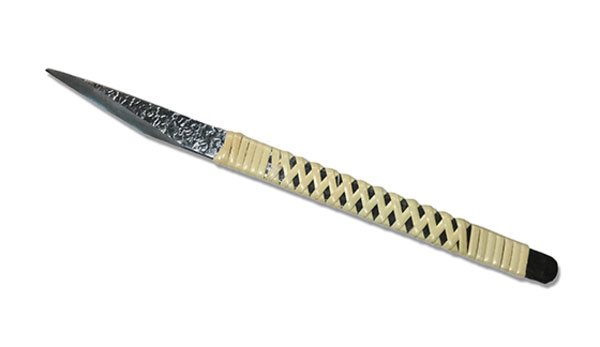 Photo:Niigata Prefecture
Photo:Niigata Prefecture
- Metal works
- Niigata
Echigo-yoita cutlery Echigo yoita uchihamono
Practical beauty born from tradition
Craftsmanship and a reputation for carpentry tools
Description
What is Echigo-yoita cutlery ?
Echigo Yoita Uchihamono are blades produced for a variety of tools in the Yoita area of Nagaoka City, Niigata Prefecture. They are smith forged, meaning red-hot metal is beaten to shape, and are distinguished by their refined sharp cutting edge and ease of use. There are 4 products designated as Traditional Crafts: planes, chisels, axes and adzes. These carpenters' tools first earned their reputation from the many temple carpenters who since the middle of the Edo period used these blades and helped build this flourishing castle town. Echigo Yoita Uchihamono have maintained their high quality over the years and are known as forged blades with a definite cutting edge and are still used regularly by craftsmen today. In recent years, Echigo Yoita Uchihamono have been used in the household and for outdoor use, and have earned a reputation as practical and high quality everyday articles.
History
The origin of Echigo Yoita Uchihamono dates back to the Warring States period. In 1578,Yamatonokami Sanetsuna NAOE, a vassal of Kenshin UESUGI, brought blacksmiths from Kasugayama to Yoita. Since the foundations of smithing had been laid by the Naoe family, they produced swords, and later on, guns. Early in the Edo period (1603 - 1868), the Yoita area was further developed and flourished as ship transportation on the Shinano river progressed. In the middle of the Edo period, they began to produce carpenters' tools, and fine works such as Doi chisels and Hyobu chisels were created. Early in the Meiji period (1868 - 1912), a swordsmith, Ryuminsai Kaneyuki MATSUNAGA began to make planes as well as swords, which led to Yoita achieving nationwide prominence as one of the major production areas of carpenters' tools. In 1986, Echigo Yoita Uchihamono were designated as Traditional Crafts in recognition of the area’s production of fine blades and the traditional skills which have been passed down for generations up to today.
General Production Process
- 1. Forging The iron base is heated in a furnace until red hot and then forged and shaped with an electric spring hammer. The metal is heated at a high temperature of over 1200°C, then evenly beaten and stretched to harden.
- 2. Forge welding The beaten iron is treated with a forge welding agent, heated in a furnace and then forge welded with a length of steel by beating with a spring hammer. The steel will form the blade edge.
- 3. Normalizing / Forging Normalizing is equalizing the structure of the metal, which makes the blade durable and highly sharp. Forging involves heating metal in a furnace, and repeatedly beating it to give the finished blade toughness and high durability.
- 4. Annealing Annealing is softening the metal, making the next process easier to carry out. In order to prevent carbon from being lost, the metal is coated with mud, heated at a temperature of about 800°C and cooled down naturally. The mud is removed before rough finishing.
- 5. Rough finishing For rough finishing, a grinder is used to thin the cutting edge.
- 6. Heat treatment The blade is heat-treated at a temperature of 400°C to strengthen the metal.
- 7. Patterning the blade The blade is patterned by beating with a patterned hammer.
- 8. Quenching / Tempering The purpose of quenching is to harden the metal to improve the wear and fatigue resistance. The blade is heated at a temperature of 800°C, cooled down quickly by plunging into water and then beaten to remove any distortions. Since quenching makes the metal hard and brittle, tempering is required. The metal is heated to a temperature of 150 to 160°C and then cooled down gradually. This procedure tempers the hardness and gives toughness to the metal.
- 9. Sharpening / Blade edging The blade is sharpened on a grinder while being kept cool with poured water. Blade edging is also a kind of sharpening method in which a blade is sharpened according to its purpose.
- 10. Fitting Every blade needs a handle, and fitting is the process where a plane blade is inserted into the plane stock; chisels and knives have their handles attached to a tang. Once the blade is fit on the handle, the product is complete.
Where to Buy & More Information
Echigo Yoita Uchihamono Union
-
Address
-
Closed* This facility is not open to the public for any exhibitions etc.
-
Website
See more Metal works
- Nambu ironware
- Takaoka copperware
- Yamagata cast iron
- Sakai cutlery
- Tokyo silverware
- Echizen cutlery
- Osaka naniwa pewterware
- Tosa cutlery
- Tsubame-tsuiki copperware
- Shinshu Forged Blades
- Banshu-miki cutlery
- Higo inlays
- Echigo-sanjo cutlery
- Echigo-yoita cutlery
- Chiba Artisan Tools
- Tokyo antimony craft
See items made in Niigata
- Ojiya chijimi textiles
- Shiozawa tsumugi silk
- Hon-shiozawa silk
- Ojiya tsumugi silk
- Niigata lacquerware
- Kamo traditional chest
- Murakami carved lacquerware
- Tsubame-tsuiki copperware
- Echigo-sanjo cutlery
- Tokamachi traditional resist-dyed textiles
- Nagaoka Buddhist altar
- Tokamachi akashi chijimi textiles
- Echigo-yoita cutlery
- Sanjo Buddhist altar
- Niigata-shirone Buddhist altar































































































































































































































































































